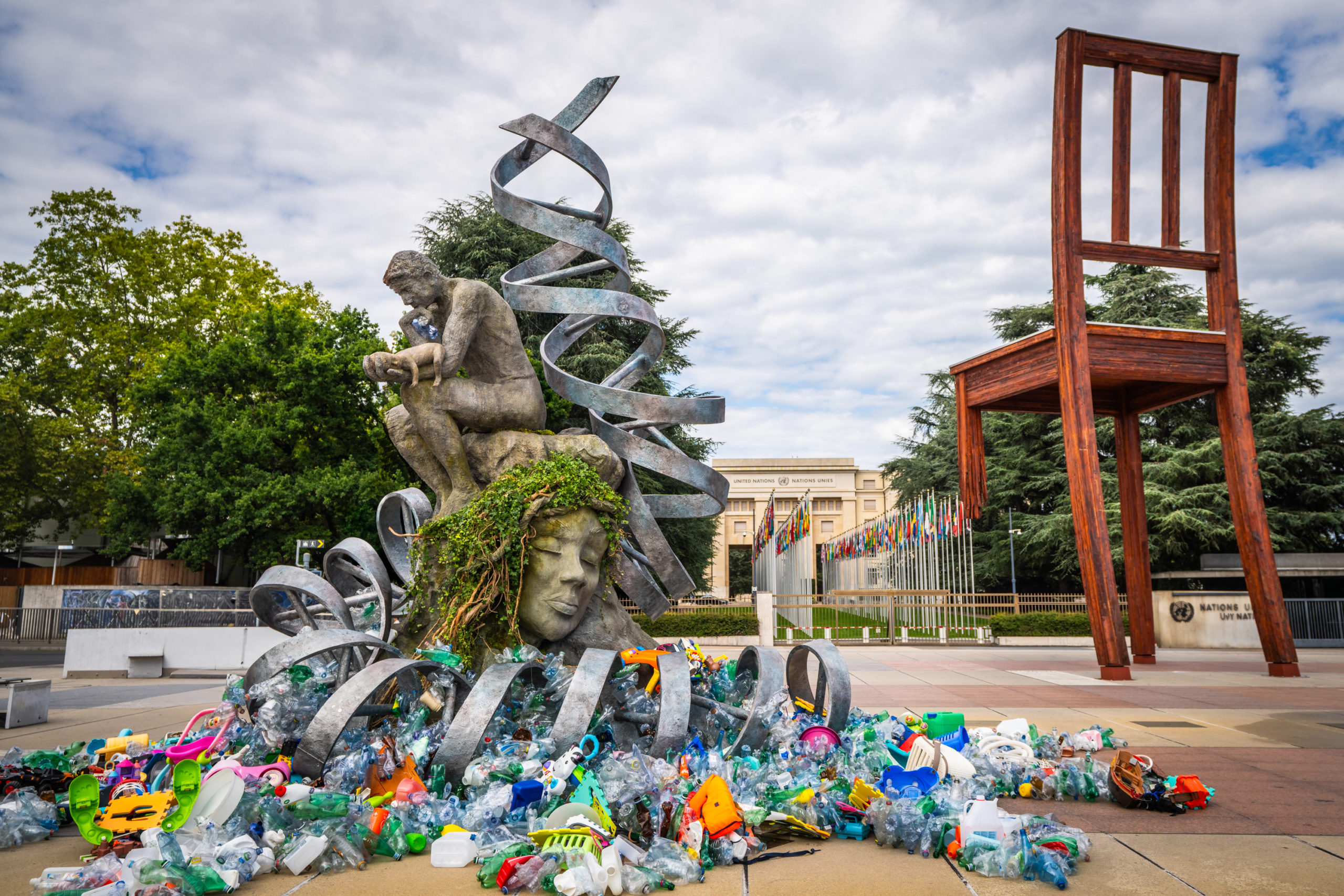This August, world leaders and negotiators gather in Geneva for the resumed fifth session of the UN Environment Assembly’s INC-5.2 conference for Global Plastics Treaty negotiations (INC 5.2). It will take place from 5-14 August whilst a six-meter-tall sculpture looms nearby, in time to remind people of the stakes and the extent of the crisis we face.
Titled The Thinker’s Burden, the monumental artwork is a reimagining of Rodin’s iconic The Thinker, created by Canadian artist and activist Benjamin Von Wong in collaboration with scenic fabrication company SLS Illusions. In Von Wong’s version, the figure is not simply lost in philosophical reflection. It cradles a baby in one arm and a crushed plastic bottle in the other. Set atop a representation of Mother Earth and encircled by a double helix of DNA, The Thinker’s Burden figurine looks down, not up, on the mess we’ve made.
“We want a healthy, clean environment and healthy, clean bodies, not just for ourselves, but for future generations,” says Von Wong. “This sculpture brings us back to the reason we’re here negotiating a plastics treaty in the first place.”
Von Wong didn’t set out to become an environmental activist. Born in Canada, with Chinese and Malaysian heritage, his background was in mining engineering before he transitioned into photography, and later, art installations.
“I would say I was happily ignoring all the woes of the world, until I chose to start paying attention,” he says. Once he began to understand the scale of environmental degradation, particularly plastic pollution, he couldn’t look away.
Over the past decade, Von Wong has become known for creating large-scale installations that transform plastic waste into powerful visual statements. From a mermaid drowning in 10,000 plastic bottles to the Guinness World Record-holding Strawpocalypse, made from over 168,000 used straws, his work has traveled from viral campaigns to the covers of UN reports.
But The Thinker’s Burden is perhaps his most ambitious piece to date in terms of scale and symbolism.
“This isn’t about prescribing a solution,” he says. “Art isn’t a marketing campaign. It’s not there to say ‘this is the one right answer.’ It’s meant to create space — to reflect, to feel, to ask: what do we owe future generations?”
Why reference Rodin’s Thinker, a work steeped in European art history and colonial legacy? According to Von Wong, that tension is intentional.
“The systems we’re negotiating within multilateralism, the UN, global governance are all built on colonial structures,” he says. “The Thinker represents that inheritance. This isn’t just about individual guilt. It’s about an entire world frozen in a system, wondering how to move forward.”
“We’re literally watching the crisis grow around us,” Von Wong says. “Every day, a little more plastic. Every day, less time.”
Unlike the governments and NGOs attending the treaty talks, Von Wong’s work is not institutionally funded. There is still a slight funding gap to make this $150,000 project a reality.
Most of the fabrication will be done in Zurich, and a detailed logistics plan was created to mobilize volunteers, community groups, and waste collectors across the city.
Despite the financial uncertainty, the project has drawn broad grassroots support. Dozens of environmental organizations, student groups, clean-up crews, and individual donors have pledged time, materials, or funding.
Von Wong doesn’t pretend that The Thinker’s Burden will fix plastic pollution. But he believes it can play a role in how we remember this moment — and what we choose to do next. He says: “This sculpture isn’t about me. I’m just the excuse. It exists because of the hundreds of people coming together to bring it to life.”
“When people say, ‘I saw your work in a presentation’ or ‘we used your image in our campaign,’ that tells me something,” he says. “We need symbols to mark the passage of time. These negotiations aren’t just technical documents. They’re turning points.”
Whether those negotiations result in meaningful change remains to be seen. But the burden, Von Wong reminds us, is already here.



